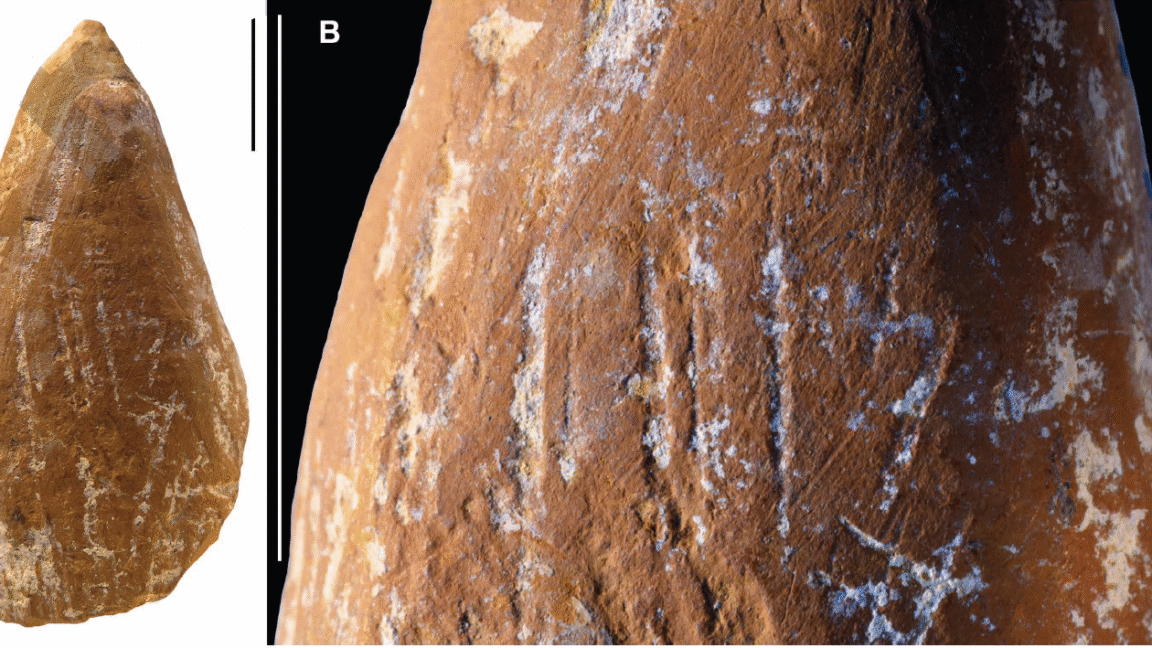Science
Neanderthals Crafted Crayons 47,000 Years Ago, Study Reveals

New research has identified two pieces of ocher from ancient rock shelters in Ukraine as tools likely used by Neanderthals for drawing, marking the earliest known examples of crayons. The artifacts, discovered in layers dating back approximately 47,000 and 46,000 years ago, exhibit clear signs of deliberate shaping and repeated resharpening, suggesting an artistic capability previously unrecognized among these ancient humans.
The rock shelters, located near the modern city of Bilohirsk in Crimea, were inhabited by Neanderthals between 100,000 and 33,000 years ago. Archaeologists have uncovered numerous chunks of ocher, a naturally occurring iron-rich mineral, from these sites. Many of these pieces show signs of wear, indicating how Neanderthals extracted pigment for various uses, including art, tool-making, and even for medicinal purposes.
Insights from the Findings
Research led by David D’Errico and his team utilized advanced techniques such as X-ray fluorescence and scanning electron microscopy to analyze a total of 16 ocher pieces. While most of these chunks could have served multiple practical purposes, two specific artifacts from a site known as Zaskalnaya V stood out. One, measuring 44.8 millimeters long and 23.3 millimeters wide, displays marks indicative of having been sharpened into a pointed crayon shape. The second artifact, a 25.4-millimeter piece of red ocher, closely resembles the first but has a broken tip.
D’Errico explained, “The combination of shaping, wear, and resharpening indicates they were used to draw or mark on soft surfaces.” Although the exact materials on which these crayons were used—such as animal hide or stone—remain unknown, the evidence points to a sophisticated understanding of color and its applications in Neanderthal culture.
A third ocher artifact from the same site features engraved lines, suggesting it may have been handled extensively, possibly for artistic or communicative purposes. The wear patterns indicate that it was not merely a tool but perhaps a culturally significant item. D’Errico noted that the angle of the incisions suggests that the individual who crafted it was likely right-handed.
Implications for Neanderthal Culture
These findings contribute to a growing body of evidence pointing to Neanderthals’ cognitive and cultural complexity. Traditionally perceived as lacking the symbolic capacity of early Homo sapiens, this research suggests that Neanderthals engaged in cultural practices that were meaningful and not purely pragmatic.
The ocher crayons from Crimea align with other archaeological discoveries, such as a 73,000-year-old drawing from Blombo Cave in South Africa, indicating that both Neanderthals and early humans independently developed artistic tools around the same time. This reinforces the idea that the impulse to create art is deeply rooted in human history.
D’Errico and his colleagues highlight the link between utilitarian and symbolic functions in traditional societies. They argue that the sustained use of ocher over thousands of years likely carried a symbolic dimension, suggesting that Neanderthals assigned meaning to colors. This understanding adds depth to our perspective on Neanderthal life, hinting at a nuanced culture that included art, communication, and perhaps even social signaling.
As research continues, it becomes increasingly clear that Neanderthals were not merely primitive beings but complex individuals capable of creative expression. The study, published in the journal Science Advances, underscores the intricate tapestry of human evolution, revealing that the drive to create and communicate through art may be a fundamental aspect of our shared ancestry.
-

 Lifestyle2 months ago
Lifestyle2 months agoWinnipeg Celebrates Culinary Creativity During Le Burger Week 2025
-

 Health3 months ago
Health3 months agoMontreal’s Groupe Marcelle Leads Canadian Cosmetic Industry Growth
-

 Science3 months ago
Science3 months agoMicrosoft Confirms U.S. Law Overrules Canadian Data Sovereignty
-

 Education2 months ago
Education2 months agoBrandon University’s Failed $5 Million Project Sparks Oversight Review
-

 Science3 months ago
Science3 months agoTech Innovator Amandipp Singh Transforms Hiring for Disabled
-

 Education2 months ago
Education2 months agoRed River College Launches New Programs to Address Industry Needs
-

 Technology2 months ago
Technology2 months agoDragon Ball: Sparking! Zero Launching on Switch and Switch 2 This November
-

 Technology3 weeks ago
Technology3 weeks agoDiscord Faces Serious Security Breach Affecting Millions
-

 Technology3 months ago
Technology3 months agoGoogle Pixel 10 Pro Fold Specs Unveiled Ahead of Launch
-

 Science2 months ago
Science2 months agoChina’s Wukong Spacesuit Sets New Standard for AI in Space
-

 Education2 months ago
Education2 months agoAlberta Teachers’ Strike: Potential Impacts on Students and Families
-

 Technology3 months ago
Technology3 months agoWorld of Warcraft Players Buzz Over 19-Quest Bee Challenge
-

 Business2 months ago
Business2 months agoRocket Lab Reports Strong Q2 2025 Revenue Growth and Future Plans
-

 Technology4 weeks ago
Technology4 weeks agoHuawei MatePad 12X Redefines Tablet Experience for Professionals
-

 Business2 months ago
Business2 months agoDawson City Residents Rally Around Buy Canadian Movement
-

 Business3 months ago
Business3 months agoNew Estimates Reveal ChatGPT-5 Energy Use Could Soar
-

 Technology3 months ago
Technology3 months agoFuture Entertainment Launches DDoD with Gameplay Trailer Showcase
-

 Science3 months ago
Science3 months agoXi Labs Innovates with New AI Operating System Set for 2025 Launch
-

 Technology3 months ago
Technology3 months agoInnovative 140W GaN Travel Adapter Combines Power and Convenience
-

 Business2 months ago
Business2 months agoBNA Brewing to Open New Bowling Alley in Downtown Penticton
-

 Technology3 months ago
Technology3 months agoGlobal Launch of Ragnarok M: Classic Set for September 3, 2025
-

 Technology3 months ago
Technology3 months agoNew IDR01 Smart Ring Offers Advanced Sports Tracking for $169
-

 Education2 months ago
Education2 months agoNew SĆIȺNEW̱ SṮEȽIṮḴEȽ Elementary Opens in Langford for 2025/2026 Year
-

 Technology2 months ago
Technology2 months agoArsanesia Unveils Smith’s Chronicles with Steam Page and Trailer










